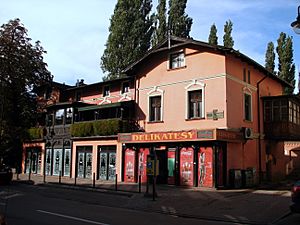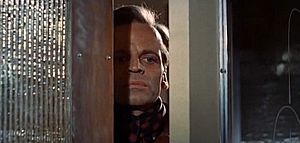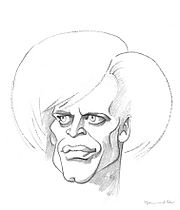Klaus Kinski facts for kids
Quick facts for kids
Klaus Kinski
|
|
|---|---|

Kinski at the 1988 Cannes Film Festival
|
|
| Born |
Klaus Günter Karl Nakszynski
18 October 1926 Zoppot, Free City of Danzig (Sopot, Poland)
|
| Died | 23 November 1991 (aged 65) Lagunitas, California, U.S.
|
| Nationality | German |
| Occupation | Actor |
| Years active | 1948–1989 |
| Spouse(s) |
|
| Children |
|
Klaus Kinski (born Klaus Günter Karl Nakszynski, 18 October 1926 – 23 November 1991) was a German actor. He was famous for his strong acting style and sometimes difficult personality. He acted in over 130 films during his 40-year career, from 1948 to 1988. He played main roles in five films directed by Werner Herzog. These films included Aguirre, the Wrath of God (1972) and Nosferatu the Vampyre (1979). Herzog later made a documentary called My Best Fiend (1999) about their challenging but creative relationship.
Kinski acted in many different types of movies, like Spaghetti Westerns (for example, For a Few Dollars More, 1965), horror films, and war movies. He also became well-known for his unusual projects, such as a one-man show about Jesus Christ and a film he directed about the musician Niccolò Paganini. He also released over 20 spoken word albums.
During his life, Kinski was known for having strong emotional reactions. Director Werner Herzog once called him "one of the greatest actors of the century, but also a monster and a great pestilence." Kinski's unique style and many films have given him a large following of fans and made him a popular icon.
Contents
Early life

Klaus Günter Karl Nakszynski was born on 18 October 1926 in Zoppot, which was then called Free City of Danzig. His parents were of Polish-German background. His father, Bruno Nakszynski, was an opera singer who later became a pharmacist. His mother, Susanne Lutze, was a nurse. Klaus had three older siblings: Inge, Arne, and Hans-Joachim.
Because of the Great Depression, his family found it hard to live in Danzig. In 1931, they moved to Berlin, where they also faced money problems. They settled in an apartment in the Schöneberg area of the city and became German citizens. In 1936, Klaus started attending the Prinz-Heinrichs-Gymnasium school.
During World War II, Klaus was called to join the German army (the Wehrmacht) in 1943 when he was 17. He served in a paratrooper unit. He did not see much fighting until the winter of 1944. His unit was sent to the German-occupied Netherlands, and he was captured by the British Army on his second day of combat. In his 1988 autobiography, Kinski claimed he had tried to leave the German army and was sentenced to death. He said he then escaped and was later shot and wounded by a British patrol before being captured.
After being treated for his injuries, he was sent to a prisoner-of-war camp in the United Kingdom. The ship taking him to Britain was attacked by a German submarine but arrived safely. In England, he was held at Camp 186 in Colchester, Essex. In his 1999 documentary My Best Fiend, Werner Herzog said that Kinski had made up many parts of his 1988 autobiography.
Career
While in the prisoner-of-war camp, Kinski started acting in shows to keep up the spirits of the prisoners. By May 1945, when the war in Europe ended, the German prisoners wanted to go home. Kinski finally returned to Germany in 1946, after being held captive for about a year and four months.
When he arrived in Berlin, he found out that his father had died during the war. His mother had been killed in an air attack on the city.
Theatrical career
After returning to Germany, Kinski began his acting career. He first worked with a small traveling theater company in Offenburg. There, he started using his new name, Klaus Kinski. In 1946, he was hired by the famous Schlosspark-Theater in Berlin. However, the next year, he was fired because of his unpredictable behavior. He worked with other theater companies, but his unusual and emotional actions often caused problems.
For three months in 1955, Kinski lived in the same boarding house as a 13-year-old Werner Herzog. Herzog would later direct Kinski in several films. In the 1999 documentary My Best Fiend, Herzog described how Kinski once locked himself in a shared bathroom for 48 hours and broke everything inside.
In March 1956, Kinski made a special appearance at Vienna's Burgtheater in Goethe's play Torquato Tasso. Even though his fellow actors respected him and the audience cheered, Kinski did not get a permanent contract. The theater's management knew about his past difficulties in Germany. He tried to sue the company but was not successful.
While jobless in Vienna, Kinski started a new career as a monologist and spoken word artist. He performed poems and stories by writers like François Villon, William Shakespeare, and Oscar Wilde. He became well-known by touring Austria, Germany, and Switzerland with his shows.
Film work
Kinski's first film role was a small part in the 1948 movie Morituri. He appeared in several German Edgar Wallace films. He also had small roles in American war movies like Decision Before Dawn (1951). In the 1961 film Die toten Augen von London, his character said he was not guilty because he was just following orders. Kinski's acting in this role showed how some people in post-war Germany did not want to take responsibility for what happened during World War II.
In the 1960s and 1970s, he acted in many European films. He also appeared in more famous movies like Doctor Zhivago (1965). In that film, he played a supporting role as a prisoner being sent to a labor camp.
He moved to Italy in the late 1960s and acted in many Spaghetti Westerns. These included For a Few Dollars More (1965) and The Great Silence (1968). In 1977, he played the role of Wilfried Böse in Operation Thunderbolt. This film was based on the real events of Operation Entebbe in 1976.
Kinski became known around the world for his work with director Werner Herzog. They made five films together: Aguirre: The Wrath of God (1972), Woyzeck (1978), Nosferatu the Vampyre (1979), Fitzcarraldo (1982), and Cobra Verde (1987).
In 1980, Kinski turned down the main villain role in Raiders of the Lost Ark. Kinski later played Kurtz, an Israeli intelligence officer, in the 1984 film The Little Drummer Girl. This movie also starred Diane Keaton.
Kinski co-starred as an evil killer from the future in a 1987 science fiction TV film called Timestalkers. His last film was Kinski Paganini (1989), which he also wrote and directed. In this movie, he played the famous violinist Niccolò Paganini.
Personal life
Kinski was married three times. His first wife was singer Gislinde Kühlbeck, whom he married in 1952. They had a daughter, Pola Kinski, and divorced in 1955. Five years later, he married actress Ruth Brigitte Tocki. Their daughter Nastassja Kinski was born in January 1961. They divorced in 1971. He married his third wife, model Minhoi Geneviève Loanic, in 1971. Their son Nikolai Kinski was born in 1976. They divorced in 1979.
Kinski published his autobiography, All I Need Is Love, in 1988. The book caused some strong reactions.
Mental health
In 1950, Kinski spent three days in a hospital that helps people with mental health challenges. This was because he had some difficult personal situations that led him to seek help. Medical records from that time noted that he had struggles with his emotions and behavior. Around this time, Kinski found it hard to get film roles.
Death
Kinski died on 23 November 1991 from a sudden heart attack. He was 65 years old and passed away at his home in Lagunitas, California. His body was cremated, and his ashes were scattered into the Pacific Ocean.
Of his three children, only his son Nikolai attended the funeral.
Legacy
Werner Herzog, in his 1999 documentary about Kinski called My Best Fiend, said that Kinski had made up many parts of his autobiography. Herzog also talked about the difficulties they had working together. Director David Schmoeller released a short film in 1999 called Please Kill Mr. Kinski. This film looked at stories of Kinski's unpredictable behavior on the set of Schmoeller's 1986 film Crawlspace. The film includes behind-the-scenes footage of Kinski's arguments with the director and crew.
In 2006, Christian David published the first detailed biography of Kinski. This book was based on new information from archives, personal letters, and interviews with Kinski's friends and colleagues. Peter Geyer also published a book of essays about Kinski's life and work.
Filmography and discography
See also
 In Spanish: Klaus Kinski para niños
In Spanish: Klaus Kinski para niños





